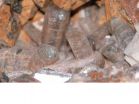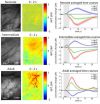(Press-News.org) Researchers at North Carolina State University have developed a new type of nanoscale structure that resembles a "nano-shish-kebab," consisting of multiple two-dimensional nanosheets that appear to be impaled upon a one-dimensional nanowire. But looks can be deceiving, as the nanowire and nanosheets are actually a single, three-dimensional structure consisting of a single, seamless series of germanium sulfide (GeS) crystals. The structure holds promise for use in the creation of new, three-dimensional (3-D) technologies.
The researchers believe this is the first engineered nanomaterial to combine one-dimensional and two-dimensional structures in which all of the components have a shared crystalline structure.
Combining the nanowire and nanosheets into a single "heterostructure" creates a material with both a large surface area and – because GeS is a semiconductor – the ability to transfer electric charges efficiently. The nanosheets provide a very large surface area, and the nanowire acts as a channel that can transmit charges between the nanosheets or from the nanosheets to another surface. This combination of features means it could be used to develop 3-D devices, such as next-generation sensors, photodetectors or solar cells. This 3-D structure could also be useful for developing new energy storage technologies, such as next-generation supercapacitors.
"We think this approach could also be used to create heterostructures like these using other materials whose molecules form similar crystalline layers, such as molybdenum sulfide (MoS2)," says Dr. Linyou Cao, an assistant professor of materials science and engineering at NC State and co-author of a paper on the research. "And, while germanium sulfide has excellent photonic properties, MoS2 holds more promise for electronic applications."
The process, Cao says, is also attractive because "it is inexpensive and could be scaled up for industrial processes."
To create the nano-shish-kebabs, the researchers begin by creating a GeS nanowire approximately 100 nanometers in width. The nanowire is then exposed to air, creating nucleation sites on the wire surface through weak oxidation. The nanowire is then exposed to GeS vapor, which forms into two-dimensional nanosheets at each of the nucleation sites.
"Our next step is to see if we can create these heterostructures in other materials, such as MoS2," Cao says. "We think we can, but we need to prove it."
INFORMATION:
The paper, "Epitaxial Nanosheet–Nanowire Heterostructures," was published online Feb. 18 in Nano Letters. The lead author is Dr. Chun Li, a former postdoctoral researcher at NC State. Co-authors are Yifei Yu, a Ph.D. student at NC State; Cao; and Dr. Miaofang Chi of Oak Ridge National Laboratory. The research was supported by the U.S. Army Research Office.
Researchers create semiconductor 'nano-shish-kebabs' with potential for 3-D technologies
2013-02-19
ELSE PRESS RELEASES FROM THIS DATE:
Theory of crystal formation complete again
2013-02-19
Exactly how a crystal forms from solution is a problem that has occupied scientists for decades. Researchers at Eindhoven University of Technology (TU/e), together with researchers from Germany and the USA, are now presenting the missing piece. This classical theory of crystal formation, which occurs widely in nature and in the chemical industry, was under fire for some years, but is saved now. The team made this breakthrough by detailed study of the crystallization of the mineral calcium phosphate –the major component of our bones. The team published their findings yesterday ...
New study shows how seals sleep with only half their brain at a time
2013-02-19
TORONTO, ON – A new study led by an international team of biologists has identified some of the brain chemicals that allow seals to sleep with half of their brain at a time.
The study was published this month in the Journal of Neuroscience and was headed by scientists at UCLA and the University of Toronto. It identified the chemical cues that allow the seal brain to remain half awake and asleep. Findings from this study may explain the biological mechanisms that enable the brain to remain alert during waking hours and go off-line during sleep.
"Seals do something biologically ...
We know when we're being lazy thinkers
2013-02-19
Are we intellectually lazy? Yes we are, but we do know when we take the easy way out, according to a new study by Wim De Neys and colleagues, from the CNRS in France. Contrary to what psychologists believe, we are aware that we occasionally answer easier questions rather than the more complex ones we were asked, and we are also less confident about our answers when we do. The work is published online in Springer's journal Psychonomic Bulletin & Review.
Research to date on human thinking suggests that our judgment is often biased because we are intellectually lazy, or ...
NYU's Shedlin publishes study on the health of Colombian refugees in Ecuador
2013-02-19
New York University College of Nursing's Professor Michele Shedlin, PhD, recently published a paper, "Sending-Country Violence and Receiving-Country Discrimination: Effects on the Health of Colombian Refugees in Ecuador," on-line in the Journal of Immigrant and Minority Health, February 2, 2013.
Studies of immigrant health have historically focused on individual-level risk factors more than environmental/structural factors as salient mediating variables. Shedlin's research addresses the need to reach a more complete understanding of the migration process and vulnerabilities ...
Study shows that diet of resistant starch helps the body resist colorectal cancer
2013-02-19
As the name suggests, you can't digest resistant starch so it ends up in the bowel in pretty much the same form it entered your mouth. As unlovely as that seems, once in the bowel this resistant starch does some important things, including decreasing bowel pH and transit time, and increasing the production of short-chain fatty acids. These effects promote the growth of good bugs while keeping bad bugs at bay. A University of Colorado Cancer Center review published in this month's issue of the journal Current Opinion in Gastroenterology shows that resistant starch also helps ...
Annals of Internal Medicine tip sheet for Feb. 19, 2013
2013-02-19
1. Acupuncture May be an Effective Alternative for Treating Seasonal Allergies
Patients receiving acupuncture treatments for seasonal allergic rhinitis reported statistically significant improvements in symptoms and decreased use of medication compared to patients having standard treatment or sham acupuncture, but the clinical significance of the observed improvements is uncertain. Allergic rhinitis (stuffy or runny nose caused by allergies) is an extremely common condition that affects approximately 20 percent of the U.S. population. Despite the availability of effective ...
Shedding new light on infant brain development
2013-02-19
New York, NY—February 18, 2013—A new study by Columbia Engineering researchers finds that the infant brain does not control its blood flow in the same way as the adult brain. The paper, which the scientists say could change the way researchers study brain development in infants and children, is published in the February 18 Early Online edition of Proceedings of the National Academy of Sciences (PNAS).
"The control of blood flow in the brain is very important" says Elizabeth Hillman, associate professor of Biomedical Engineering and of Radiology, who led the research study ...
The role of goop: Research shows pollution doesn't change the rate of droplet formation
2013-02-19
When it comes to forming the droplets that make up clouds, a little oily and viscous organic material apparently doesn't matter that much. And that's good news for reducing the uncertainty of climate model predictions.
Understanding cloud formation is essential for accurate climate modeling, and understanding cloud formation begins with the droplets that make up clouds. Droplets form when water vapor is attracted to particles floating in the atmosphere. These particles include dust, sea salt from the ocean, microorganisms, soot, sulfur – and organic material that can ...
Study suggests women have higher risk of hip implant failure
2013-02-19
Women appear to have a higher risk of implant failure than men following total hip replacement after considering patient-, surgery-, surgeon-, volume- and implant-specific risk factors, according to a report published Online First by JAMA Internal Medicine, a JAMA Network publication.
Total hip replacement, also known as total hip arthroplasty (THA), is more often performed in women than men. Sex-specific risk factors and outcomes have been investigated in other major surgical procedures and, in theory, might be more important to study in THA because of anatomical differences ...
Study suggests reduced lung function in infancy associated with wheeze later
2013-02-19
A study in Australia suggests that reduced lung function in infancy was associated with wheezing beyond childhood at 18 years of age, according to a report published Online First by JAMA Pediatrics, a JAMA Network publication.
Abnormal airway function is characteristic of asthma and chronic obstructive airways disease, and other studies have suggested that reduced lung function is already apparent in childhood and tracks through adulthood. However, the relationship between the age of onset of airway dysfunction and wheeze, a symptom of obstructive airways disease, has ...

